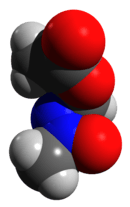Methylazoxymethanol acetate
| |||
| Names | |||
|---|---|---|---|
| IUPAC name
(Z)-acetyloxymethylimino-methyl-oxidoazanium | |||
| Other names
MAM | |||
| Identifiers | |||
| 3D model (Jmol) | Interactive image | ||
| ChemSpider | 19953632 | ||
| ECHA InfoCard | 100.008.879 | ||
| EC Number | 209-765-7 | ||
| KEGG | C19258 | ||
| MeSH | D008746 | ||
| PubChem | 5363199 | ||
| |||
| |||
| Properties | |||
| C4H8N2O3 | |||
| Molar mass | 132.11792 | ||
| Except where otherwise noted, data are given for materials in their standard state (at 25 °C [77 °F], 100 kPa). | |||
| Infobox references | |||
Methylazoxymethanol acetate, MAM, is a neurotoxin which reduces DNA synthesis[1] used in making animal models of neurological diseases including schizophrenia[2] and epilepsy.[3] MAM is found in cycad seeds, and causes zamia staggers. It selectively targets neuroblasts in the central nervous system. In rats, administration of MAM affects structures in the brain which are developing most quickly.[2]
MAM animal models
Schizophrenia
In rat models, the specific effect of MAM on neural development depends on the gestational age of the subject. At the seventeenth gestational day (GD17), administration of MAM produces behavioral and histopathological patterns found in schizophrenia.[2] The molecular mechanism behind this model is not fully known.[4] Methylazoxymethanol acetate administered at GD17 reduces the thickness of the hippocampus and the thalamus. The locomotor effects of amphetamines and the spontaneous firing rate of dopaminergic neurons in the ventral tegmental area are increased. In alternating maze tests, GD17 MAM rats quickly learned the first rule, but took longer to accommodate to alterations to the rule; this is thought to indicate deficits in working spatial memory, which is also impaired in schizophrenia.[2]
Epilepsy
Exposure to MAM before birth increases susceptibility to epileptic seizures caused by flurothyl.[3] Prenatal MAM exposure in rats results in a model of brain malformation. In some MAM animals, video-EEG monitoring has documented the presence of spontaneous electrographic seizure activity [5] In some epilepsy rat models, MAM is administered at the fifteenth gestational day. Previous studies have found impaired cognitive function in GD15 MAM rats, and a reduced seizure threshold.[6] At the cellular level, dysplastic hippocampal neurons in the MAM model were shown to have reduced potassium current function and expression for the Kv4.2 channel subunit [7] These findings may contribute to the spontaneous seizures and reduced seizure thresholds seen in this model.
References
- ↑ "Methylazoxymethanol Acetate – Compound Summary". PubChem. National Center for Biotechnology Information. Retrieved 9 June 2012.
- 1 2 3 4 Jones, CA; Watson, DJG; Fone, KCF (1 October 2011). "Animal models of schizophrenia". British Journal of Pharmacology. 164 (4): 1162–1194. doi:10.1111/j.1476-5381.2011.01386.x.
- 1 2 Baraban, Scott C.; Schwartzkroin, Philip A. (31 March 1996). "Flurothyl seizure susceptibility in rats following prenatal methylazoxymethanol treatment". Epilepsy Research. 23 (3): 189–194. doi:10.1016/0920-1211(95)00094-1.
- ↑ Hradetzky, Eva; et al. (28 September 2011). "The Methylazoxymethanol Acetate (MAM-E17) Rat Model: Molecular and Functional Effects in the Hippocampus". Neuropsychopharmacology. 37 (2): 364–377. doi:10.1038/npp.2011.219.
- ↑ Harrington, Emily; et al. (January 2007). "Altered glutamate receptor-transporter and spontaneous seizures in rats exposed to methylazoxymethanol in utero". Epilepsia. 48 (1): 158–168. doi:10.1111/j.1528-1167.2006.00838.x.
- ↑ Moshé, editors, Asla Pitkänen, Philip A. Schwartzkroin, Solomon L. (2006). Models of seizures and epilepsy. Amsterdam: Elsevier Academic. pp. 305–312. ISBN 0120885549.
- ↑ Castro, Peter; et al. (1 September 2001). "AHippocampal heterotopia lack functional Kv4.2 potassium channels in the methylazoxymethanol model of cortical malformations and epilepsy.". Journal of Neuroscience. 21 (17): 6626–6634. doi:10.1111/j.1528-1167.2011.03264.x.

